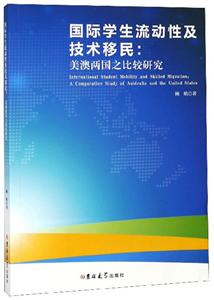掃一掃
關(guān)注中圖網(wǎng)
官方微博
本類五星書更多>
-
>
妙相梵容
-
>
基立爾蒙文:蒙文
-
>
我的石頭記
-
>
心靈元氣社
-
>
女性生存戰(zhàn)爭
-
>
縣中的孩子 中國縣域教育生態(tài)
-
>
(精)人類的明天(八品)
國際學生流動性及技術(shù)移民 版權(quán)信息
- ISBN:9787569246629
- 條形碼:9787569246629 ; 978-7-5692-4662-9
- 裝幀:一般膠版紙
- 冊數(shù):暫無
- 重量:暫無
- 所屬分類:>>
國際學生流動性及技術(shù)移民 內(nèi)容簡介
為了能夠吸引科技工作者、國際學生和勞動力移民等不同層次的人才,發(fā)達國家與發(fā)展中國家制定了相應(yīng)政策和國家戰(zhàn)略,同時積極鼓勵在海外技術(shù)強國工作的人才回國。本研究旨在擴展對不同國家科技人力資源(HRST)流動性的理解,闡述用于管理和塑造流動性的政策。本研究對澳大利亞和美國實施的策略進行對比,將審視已經(jīng)設(shè)計和實施的策略變化——特別是入境和移民方面的法規(guī)和政策,并分析這兩個國家里國際學生的流動性。
國際學生流動性及技術(shù)移民 目錄
Chapter 1: Introduction
1.1 Statement of the problem
1.2 Significance of this study
1.3 Research questions
1.4 Conceptual framework
1.5 Definitions of terms
Chapter 2: International Students Mobility in the USA and Australia
2.1 Trends in international students mobility in Australia
2.2 Trends in international students mobility in the United States
2.3 Comparison between Australia and the United States
2.4 Changes in ISM and skilled migration policies in Australia
2.5 Changes in ISM and skilled migration policies in the U.S.A
2.5 Comparison of the policy changes between the U.S.A and Australia
Chapter 3: Research Methodology
3.1 Population and sample of the study
3.2 Research design and rationale
3.3 Instrumentation
3.4 Data collection procedure
3.5 Data organization during collection
3.6 Ethical research and considerations
3.7 Internal and external vafidity of research findings
3.8 Reliability of the research
Chapter 4: Data Analysis Methods and Techniques
4.1 Format of the collected data
4.2 Data analysis tools and equipment
4.2.1 Constant comparison analysis
4.2.2 Computerized qualitative data analysis
Chapter 5: Student Mobility and Skilled Migration Policies and Influences
5.1 Distribution of the research participants
5.2 Presentation of findings
5.2.1 Higher education in Australia
5.2.2 Higher education in the United States
5.2.3 Comparison of higher education in Australia and the United States
5.2.4 Student mobility and skilled migration policies in the United States and Australia
5.2.5 Use of agents in international student's recruitment in Australia and the U.S.
5.2.6 Comparing the Chinese students in Australia and the United States
Chapter 6: International Mobility of Human Capital in China and OECD Member Countries
6.1 international students mobility in Chino
6.2 Various processes influencing Chinese government
6.3 Recommendations to relevant Chinese stakeholders
6.4 The migration of skilled workers: global mobility and the "war for talent".
6.5 The skills and characteristics of the mobility of the highly skilled among OECD countries
6.6 Facts to drive highly qualified people to move internationally
6.7 Foreign students in OECD countries ore potential labor force reserve
6.8 The role of migrant policies in the USA, Australia, and other OECD countries
Chapter 7: Implications and Recommendation
7.1 Interpretation of the findings
7.2 Implications of the research findings and results
7.3 Limitations of the study
7.4 Recommendations for further research
7.5 Conclusion
References
Appendix A: Interview Questions
Appendix B: List of Interviewees
1.1 Statement of the problem
1.2 Significance of this study
1.3 Research questions
1.4 Conceptual framework
1.5 Definitions of terms
Chapter 2: International Students Mobility in the USA and Australia
2.1 Trends in international students mobility in Australia
2.2 Trends in international students mobility in the United States
2.3 Comparison between Australia and the United States
2.4 Changes in ISM and skilled migration policies in Australia
2.5 Changes in ISM and skilled migration policies in the U.S.A
2.5 Comparison of the policy changes between the U.S.A and Australia
Chapter 3: Research Methodology
3.1 Population and sample of the study
3.2 Research design and rationale
3.3 Instrumentation
3.4 Data collection procedure
3.5 Data organization during collection
3.6 Ethical research and considerations
3.7 Internal and external vafidity of research findings
3.8 Reliability of the research
Chapter 4: Data Analysis Methods and Techniques
4.1 Format of the collected data
4.2 Data analysis tools and equipment
4.2.1 Constant comparison analysis
4.2.2 Computerized qualitative data analysis
Chapter 5: Student Mobility and Skilled Migration Policies and Influences
5.1 Distribution of the research participants
5.2 Presentation of findings
5.2.1 Higher education in Australia
5.2.2 Higher education in the United States
5.2.3 Comparison of higher education in Australia and the United States
5.2.4 Student mobility and skilled migration policies in the United States and Australia
5.2.5 Use of agents in international student's recruitment in Australia and the U.S.
5.2.6 Comparing the Chinese students in Australia and the United States
Chapter 6: International Mobility of Human Capital in China and OECD Member Countries
6.1 international students mobility in Chino
6.2 Various processes influencing Chinese government
6.3 Recommendations to relevant Chinese stakeholders
6.4 The migration of skilled workers: global mobility and the "war for talent".
6.5 The skills and characteristics of the mobility of the highly skilled among OECD countries
6.6 Facts to drive highly qualified people to move internationally
6.7 Foreign students in OECD countries ore potential labor force reserve
6.8 The role of migrant policies in the USA, Australia, and other OECD countries
Chapter 7: Implications and Recommendation
7.1 Interpretation of the findings
7.2 Implications of the research findings and results
7.3 Limitations of the study
7.4 Recommendations for further research
7.5 Conclusion
References
Appendix A: Interview Questions
Appendix B: List of Interviewees
展開全部
國際學生流動性及技術(shù)移民 作者簡介
顧皓,清華大學管理學博士,清華大學(高等教育學)博士后,清華大學聯(lián)合國教科文國際工程教育中心博士后研究員。主要研究方向為:教育經(jīng)濟與管理。
書友推薦
- >
我從未如此眷戀人間
- >
煙與鏡
- >
龍榆生:詞曲概論/大家小書
- >
李白與唐代文化
- >
二體千字文
- >
小考拉的故事-套裝共3冊
- >
山海經(jīng)
- >
唐代進士錄
本類暢銷

















